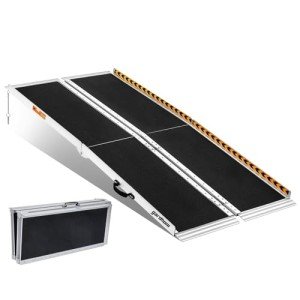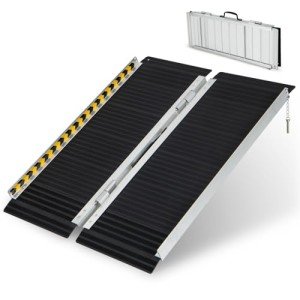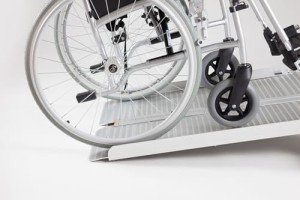Folding portable wheelchair ramps have become essential tools for enhancing mobility and accessibility for those with physical disabilities. As society increasingly advocates for inclusivity, the importance of such ramps cannot be understated. These ramps facilitate easy movement over steps, curbs, doorways, and other obstacles, allowing individuals using wheelchairs to navigate their environments with greater independence and confidence.
Understanding Folding Portable Wheelchair Ramps
Folding portable wheelchair ramps are designed to be lightweight, easily transportable, and user-friendly. They boast a unique design that allows them to be folded for convenient storage and transportation. These ramps can be used in a variety of settings, including homes, offices, and public spaces.
Key Features
- Portability: Most folding ramps can be effortlessly folded into a compact size that fits easily in a vehicle or storage area.
- Durability: Constructed from strong materials such as aluminum, these ramps are designed to withstand daily wear and tear while supporting significant weight.
- Surface Grip: Equipped with non-slip surfaces, these ramps ensure safety during use, especially when encountering wet or uneven surfaces.
- Adjustability: Many models feature adjustable height options to accommodate a range of obstacles.
- Ease of Setup: Folding ramps are typically designed for quick setup without the need for tools, allowing users to deploy them effectively within minutes.
Types of Folding Portable Wheelchair Ramps
Folding portable wheelchair ramps come in various sizes and designs to meet different needs. Here are some common types:
-
Single-Fold Ramps: These ramps fold in half lengthwise, making them easy to transport and store. They are ideal for use with smaller steps or curbs.
-
Multi-Fold Ramps: As the name suggests, these ramps may have two or three sections that fold for compactness. They are often longer, making them suitable for taller thresholds.
-
Suitcase Ramps: Similar to single-fold ramps, suitcase ramps feature a unique design that allows them to fold in half and resemble a suitcase. They often come with a carrying handle for easy transport.
-
Walk & Roll Ramps: These ramps are designed specifically for rolling over longer distances with ease and tend to be wider, providing a smooth transition for users.
Choosing the Right Ramp
Selecting the appropriate folding portable wheelchair ramp requires careful consideration of various factors. Potential users should take the following into account:
- Weight Capacity: Ensure the ramp can support the total weight of the wheelchair plus the user.
- Length: The ramp’s length should accommodate the height of the obstacle it will be used with, following the general guideline of a 1:12 slope ratio (1 inch of height equals 12 inches of ramp).
- Surface Material: Consider the materials used in the ramp's construction. Aluminum ramps are common due to their durability and lightweight portability.
- Width: The ramp should be wide enough to accommodate the user's wheelchair comfortably.
Benefits of Folding Portable Wheelchair Ramps
The benefits of using folding portable wheelchair ramps extend beyond mere convenience. They can greatly enhance quality of life and foster independence. Below are some of the significant advantages of these ramps:
-
Increased Accessibility: Ramps make homes and public spaces more accessible to individuals with mobility challenges. They eliminate barriers often posed by steps and curbs.
-
Enhanced Safety: Using a ramp reduces the risk of falls and injuries that can occur when navigating stairs or uneven surfaces in a wheelchair.
-
Convenience: Their portability allows users to take ramps wherever they go, making travel and excursions much easier.
-
Cost-Effective: Compared to constructing permanent wheelchair ramps, portable options are generally more affordable and do not require extensive installation.
-
Flexibility: Users can adapt the ramp for various situations, whether at home, work, or in public, providing flexibility that fixed ramps may not offer.
Considerations for Use
While folding portable wheelchair ramps offer numerous advantages, it’s essential to use them correctly to ensure safety. Here are some key considerations:
- Training: Proper instruction on how to set up and use the ramps is crucial for both users and caregivers.
- Terrain: Assess the ground conditions where the ramp will be used to ensure stability and avoid slipping.
- Maintenance: Regularly inspect the ramp for signs of wear, cracks, or rust, especially if it is used outdoors.
Frequently Asked Questions (FAQs)
1. How much weight can a folding portable wheelchair ramp hold?
Most folding portable wheelchair ramps can support between 600 to 800 pounds. However, it’s essential to check the specifications of individual models as this can vary.
2. Can a folding portable wheelchair ramp be used outdoors?
Yes, many folding portable ramps are designed for outdoor use and can withstand the elements. Nonetheless, ensure to check the materials and product specifications for durability.
3. How long should a wheelchair ramp be for a step of 12 inches?
The general recommendation is a 1:12 slope ratio, meaning a 12-inch step would require a ramp that is at least 12 feet long to ensure safe navigation.
4. Can I store the ramp in my car?
Yes, folding portable wheelchair ramps are designed to be compact and easily stored in most vehicles, making them suitable for travel.
5. Are there any safety tips for using wheelchair ramps?
Always ensure the ramp is placed on a flat, stable surface, and check for any obstructions. Use the ramp slowly and avoid rushing for safer navigation.
Folding portable wheelchair ramps are a significant advancement in promoting mobility and accessibility for individuals using wheelchairs. Their portability, safety features, and versatility make them an invaluable asset in achieving a more inclusive society. As communities move towards greater accessibility, the continued investment in features and options for folding ramps will expand, further improving the quality of life for those facing mobility challenges. Whether through home adjustments or public infrastructure, embracing these solutions is a step towards greater equality and independence for all.







